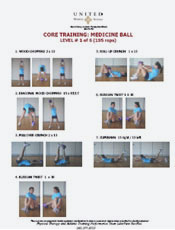|
PT Classroom - The Importance of Core Training for Athletes ׀ by Dino Laurenzi, L-ATC, MA, MBA, TRX Trainer & Jennifer Hill, MPT, CSCS |

Dino Laurenzi, L-ATC, MA, MBA, TRX Trainer, graduated from the University of North Carolina with a degree in Sports Medicine and Athletic Training. He has worked with clients ranging from professional to fitness athletes. Dino has developed various sports medicine and athletic performance training programs to assist his clients to achieve better performance and improved fitness. Dino is currently the Director of Rehabilitation at United Hospital System. |
|
The Importance of Core Training for Athletes
Core Training Exercises - Body Weight & Stability Ball  Core
Training: Body Weight Routine Core
Training: Body Weight Routine
Core Training: Combination Routine
Core Training Level I: Stability Ball
Core Training Level II: Stability Ball
Core Training Level III: Stability Ball
Core Training Level IV: Stability Ball
Core Training Level V: Stability Ball
Core
Training Post Chain: Stability Ball
Core Training Exercises - Medicine Ball
Core Training Level II: Medicine Ball
Core Training Level III: Medicine Ball
Core Training Level IV: Medicine Ball
Core Training Level V: Medicine Ball
Core Training Level VI: Medicine Ball
Disc Pillow Exercises
Disc Pillow Exercises - Lower Chain II
Disc Pillow Exercises - Lower Chain III
Disc Pillow Exercises - Lower Chain IV
Disc Pillow Exercises - Lower Chain V
Core Training Exercises - Kettlebell
Last revised: January 14, 2009 |
|
|
|
|

 Core
training is a very important aspect of an exercise routine for
athletes. When incorporated into a proper workout routine it will
help improve neuromuscular control and hopefully reduce injuries.
The trunk of the body is considered the core and is comprised of the
abdominal muscles, back muscles, pelvic floor muscles and the
diaphragm. The core is the basis for all functional movements in
sports, and is crucial for everything from cutting, to pivoting, to
throwing, etc. Its main purposes are to allow for balance &
stability, absorbing force and for the transfer of force/energy to
the extremities. The transfer of force/energy affords the athlete
the ability to generate additional power with various athletic
activities such as a golf swing or a punch.
Core
training is a very important aspect of an exercise routine for
athletes. When incorporated into a proper workout routine it will
help improve neuromuscular control and hopefully reduce injuries.
The trunk of the body is considered the core and is comprised of the
abdominal muscles, back muscles, pelvic floor muscles and the
diaphragm. The core is the basis for all functional movements in
sports, and is crucial for everything from cutting, to pivoting, to
throwing, etc. Its main purposes are to allow for balance &
stability, absorbing force and for the transfer of force/energy to
the extremities. The transfer of force/energy affords the athlete
the ability to generate additional power with various athletic
activities such as a golf swing or a punch. 
 Disc
Pillow Exercises - Lower Chain I
Disc
Pillow Exercises - Lower Chain I Core
Training Kettlebell
Core
Training Kettlebell




